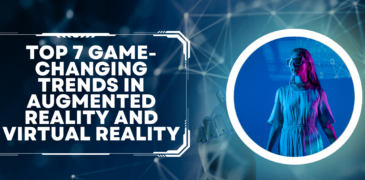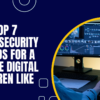As we traverse the ever-evolving realms of technology, Augmented Reality (AR) and Virtual Reality (VR) stand out as transformative forces, reshaping how we perceive and interact with the digital world. On the occasion of ChatGPT’s first anniversary, we delve into the top seven game-changing trends in AR and VR. From advancements in immersive experiences to the integration of AR in everyday applications, these trends promise to redefine the boundaries of reality and unlock new possibilities. Join us on a journey into the future where augmented and virtual realities converge, offering unparalleled experiences that transcend the limitations of the physical realm.
Immersive Extended Reality (XR) Experiences
Immersive Extended Reality (XR) Experiences represent a revolutionary convergence of Augmented Reality (AR) and Virtual Reality (VR), ushering in a new era of seamless, dynamic interactions with digital and physical worlds. This trend transcends the limitations of traditional AR and VR, enabling users to fluidly move between augmented and virtual environments within a single experience.
Advancements in XR technologies include more realistic simulations, interactive storytelling, and lifelike digital overlays on the physical world. This fusion allows for unprecedented immersion, making XR a game-changer in entertainment, education, and professional training. Users can engage with digitally rendered elements as if they were tangible, blurring the lines between reality and the virtual realm. AR-enhanced tours or navigating immersive VR simulations for training purposes, XR experiences redefine how individuals interact with information and environments. As technology continues to evolve, the potential applications of XR are limitless, promising transformative experiences that cater to the diverse needs of users in an increasingly interconnected and digitized world.
Spatial Computing and Interaction
Spatial Computing and Interaction mark a paradigm shift in the realms of Augmented Reality (AR) and Virtual Reality (VR), introducing a three-dimensional spatial context to digital experiences. This trend goes beyond traditional interfaces, allowing users to engage with digital elements seamlessly in real-world space. Spatial computing enhances the sense of immersion, providing more natural and intuitive interactions with virtual objects.
Spatial computing involves the understanding and utilization of physical space, enabling digital content to be anchored and manipulated in relation to the user’s environment. Users can interact with virtual elements as if they exist in the same physical space, fostering a heightened sense of presence and realism. It holds the potential to redefine how we navigate and interact with digital information, bridging the gap between the virtual and physical worlds in ways previously unimaginable. The result is a more intuitive and immersive computing experience that aligns seamlessly with our natural spatial awareness.
AR Integration in Everyday Life
AR Integration in Everyday Life signifies a transformative trend where Augmented Reality (AR) seamlessly blends with routine activities, enhancing how individuals interact with their surroundings through digital overlays. From navigation applications offering real-time directions to interactive shopping experiences, AR is becoming an integral part of daily life. AR overlays provide users with contextual information about their surroundings, such as points of interest or directions, enhancing the navigation experience. AR is also making waves in shopping, allowing consumers to virtually try on clothing or visualize furniture in their homes before making purchase decisions.
In Everyday Life signifies a transformative trend where Augmented Reality (AR) seamlessly blends with routine activities, enhancing how individuals interact with their surroundings through digital overlays. From navigation applications offering real-time directions to interactive shopping experiences, AR is becoming an integral part of daily life.
AR overlays provide users with contextual information about their surroundings, such as points of interest or directions, enhancing the navigation experience. AR is also making waves in shopping, allowing consumers to virtually try on clothing or visualize furniture in their homes before making purchase decisions.
Educational tools leverage AR to bring learning materials to life, making complex concepts more accessible through interactive visualizations. Moreover, AR applications in healthcare offer surgeons real-time data during procedures or assist medical professionals in training scenarios. As AR continues to evolve, its integration into everyday life is expanding, enriching experiences across diverse sectors. From enhancing productivity to providing personalized information.
5G-Powered AR and VR
The emergence of 5G technology has ushered in a transformative era for Augmented Reality (AR) and Virtual Reality (VR), propelling these immersive technologies to unprecedented levels of performance and connectivity. 5G-Powered AR and VR represent a paradigm shift, addressing key challenges such as latency and bandwidth constraints. The high-speed, low-latency capabilities of 5G networks significantly enhance the user experience in AR and VR applications. Reduced latency ensures that interactions within virtual environments are more instantaneous and responsive, contributing to a more realistic and immersive user experience.
This advancement is particularly impactful in scenarios like live-streaming VR events or engaging in AR applications that demand real-time responsiveness. 5G’s increased bandwidth also supports the seamless delivery of high-quality, data-intensive AR and VR content, eliminating buffering and ensuring smooth, high-definition experiences.
Enterprise Adoption of XR
The Enterprise Adoption of Extended Reality (XR) marks a transformative trend as organizations harness the power of Augmented Reality (AR) and Virtual Reality (VR) for various business applications. XR technologies are increasingly being integrated into enterprise environments, reshaping workflows, training programs, and collaboration methods.
In sectors such as manufacturing, XR facilitates immersive training simulations, allowing employees to practice tasks in a virtual environment before executing them in the real world. This not only enhances employee skills but also reduces the risk associated with hands-on training. Collaboration in a globalized workspace is evolving through XR, enabling remote teams to meet in shared virtual spaces. This fosters more natural and effective communication, transcending geographical barriers and enhancing the efficiency of teamwork.
Augmented Commerce (AR Shopping)
Augmented Commerce, commonly known as AR Shopping, is reshaping the e-commerce landscape by introducing immersive and interactive experiences for consumers. This transformative trend employs Augmented Reality (AR) to provide users with a dynamic and personalized shopping journey. AR Shopping allows customers to virtually visualize products in their real-world surroundings before making purchase decisions. Retailers leverage AR applications to enable customers to try on clothing, experiment with various cosmetic products. Or visualize furniture within their homes—all through the lens of their mobile devices or AR glasses. This interactive approach not only enhances the online shopping experience but also reduces uncertainty and the likelihood of returns.
As technology advances, AR is poised to play a pivotal role in revolutionizing how consumers browse and shop. Fostering a new era where digital and physical retail environments converge to create seamless and visually rich shopping experiences. This trend reflects the evolving nature of commerce, where the boundaries between the online and offline realms are becoming increasingly blurred.
Healthcare Transformation through VR
The Healthcare Transformation through Virtual Reality (VR) represents a groundbreaking trend. That leverages immersive technologies to revolutionize various aspects of the medical field. VR is increasingly employed across healthcare domains, offering innovative solutions. For patient care, medical training, and mental health treatment. VR is utilized for therapeutic interventions, pain management, and rehabilitation. Patients can undergo immersive experiences that distract from pain or provide virtual environments for physical therapy, enhancing overall well-being.
As VR technologies continue to evolve, the healthcare industry is poised for transformative changes. Fostering a future where immersive experiences contribute to enhanced patient care, medical education, and mental health support. The integration of VR exemplifies the innovative ways technology is advancing healthcare. Creating more effective and patient-centric solutions.
Conclusion
In conclusion, the game-changing trends in Augmented Reality and Virtual Reality. Unveil a future where digital experiences seamlessly intertwine with reality. From XR’s immersive environments to the practical applications of AR in daily life. The transformative potential of 5G-powered connectivity, these trends redefine how we perceive, interact, and learn. Enterprise adoption of XR and the fusion of AR with commerce and healthcare showcase the profound impact on industries.
Read more:







